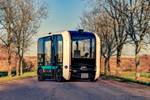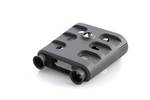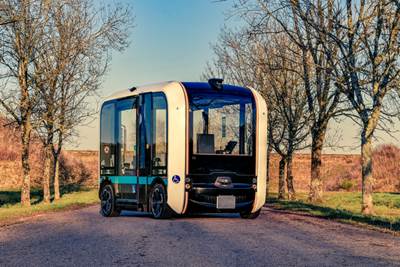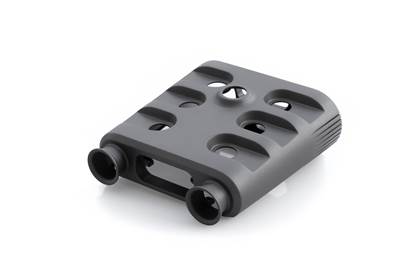3D-printed composite tail rotor gear box housing enhances Discovery super drone
CFP Technology teams with Flying-Cam to create 3D-printed, functional tail rotor actuators protection using Windform XT 2.0 composites and a powder bed fusion process.
Share
Read Next
Detail of Discovery’s tail rotor gear box housing. Photo Credit, all images: Flying-Cam
CRP Technology’s (Modena, Italy) long-term collaboration with unmanned airborne solutions developer (Belgium) has resulted in the construction of the UAV Discovery’s tail rotor gear box housing — the main housing attached to the main tail boon. The flight-ready part is 3D-printed (powder bed fusion/PFB) using CRP’s Windform XT 2.0 composite material.
Discovery is a 75-kilogram maximum takeoff weight (MTOW) unmanned single-rotor helicopter. It is Flying-Cam’s newest, largest and most versatile system so far with increased endurance features. Fully integrated state-of-art sensors were carefully chosen to match the platform quality for a variety of applications ranging from entertainment, homeland security, earth monitoring and high-precision remote sensing generally.
“With the potential drones offer the civil market, and the interest in beyond visual line of sight [BVLOS] flights, we felt it was the right time to develop a drone that could not only capture beautiful imagery for movies, television shows and commercials, but that could carry a variety of payloads to collect the necessary data for other industrial applications,” Emmanuel Previnaire, founder and CEO of Flying-Cam, says.
The aim of the “super drone” project was to create a lightweight yet rigid physical and aerodynamic protection for the tail rotor actuators and the GPS antenna. Flying-Cam opted for CRP Technology’s proprietary high-performance Windform Top-Line range of composite materials, particularly Windform XT 2.0, a carbon fiber-filled polyamide-based 3D printing composite especially suitable in demanding applications for such a sector as motorsports, aerospace and UAV.
Flying-Cam’s Discovery during flight.
The material replaced the previous formula of Windform XT in the Windform Top-Line family of materials for PBF created by CRP Technology, featuring improvements in mechanical properties including +8% increase in tensile strength, +22% in tensile modulus and a +46% increase in elongation at break.
“The component was planned to be clamped on the tail boom, and also support the carbon [fiber] plate used as a tail rotor ground protection,” Previnaire notes. “For this reason, a good stress resistance was needed. We chose Windform XT 2.0 as it allows us to achieve a good weight-resistance ratio.” Moreover, the mechanical and thermal properties of Windform materials are strictly connected to the characteristics of the 3D printing process.
“The most innovative aspect in enlisting the 3D printing process and composite materials supplied by CRP Technology, is the free shape design, important for aerodynamic purpose, as well as the ability to create complex wiring channels inside with strong attachment points, in one unique piece,” Previnaire underlines. “More specifically, the PBF process and Windform materials are said to enable the creation of hollow parts with a lot of functional details, such as fixation nuts integration, cable attachment points.”
“We started collaborating with CRP Technology many years ago, for the realization of SARAH 3.0, our electric vertical takeoff and landing [eVTOL] unmanned aerial system, now replaced by SARAH 4.0,” Previnaire adds. “CRP Technology 3D printed the airframe structure, air guide cooling system, tail unit and main battery connection.”
SARAH, as well as Discovery, is reported to be a cutting-edge “unmanned aerial intelligence” solution and only possible by mastering all the technologies and skills involved.
Related Content
JEC World 2024 highlights: Thermoplastic composites, CMC and novel processes
CW senior technical editor Ginger Gardiner discusses some of the developments and demonstrators shown at the industry’s largest composites exhibition and conference.
Read MorePlant tour: Airbus, Illescas, Spain
Airbus’ Illescas facility, featuring highly automated composites processes for the A350 lower wing cover and one-piece Section 19 fuselage barrels, works toward production ramp-ups and next-generation aircraft.
Read MoreLow-cost, efficient CFRP anisogrid lattice structures
CIRA uses patented parallel winding, dry fiber, silicone tooling and resin infusion to cut labor for lightweight, heavily loaded space applications.
Read MoreInfinite Composites: Type V tanks for space, hydrogen, automotive and more
After a decade of proving its linerless, weight-saving composite tanks with NASA and more than 30 aerospace companies, this CryoSphere pioneer is scaling for growth in commercial space and sustainable transportation on Earth.
Read MoreRead Next
Autonomous, electric shuttle retrofitted with CRP Technology Windform materials
Advanced 3D printing production process and Windform composite materials used to manufacture the required motor cover and washer reservoir flap valve components, account for Olli 2.0’s pod-like shape.
Read MoreCRP Technology highlights Windform RS composite material for powder bed fusion processes
Polyamide-based carbon fiber-filled composite provides enhances functionality, flexibility and speed in developing intricate 3D-printed parts.
Read MoreNext-gen fan blades: Hybrid twin RTM, printed sensors, laser shock disassembly
MORPHO project demonstrates blade with 20% faster RTM cure cycle, uses AI-based monitoring for improved maintenance/life cycle management and proves laser shock disassembly for recycling.
Read More












